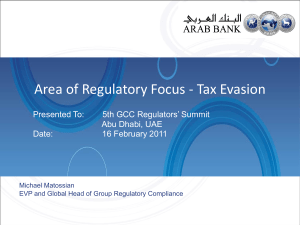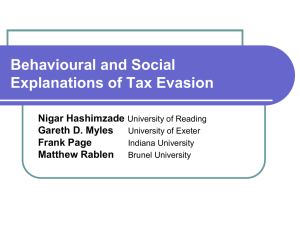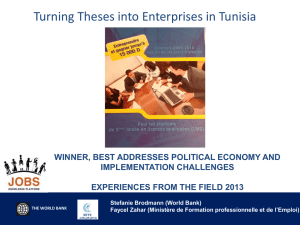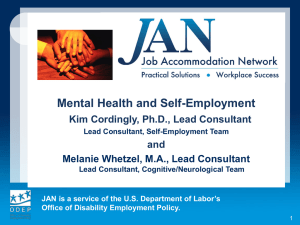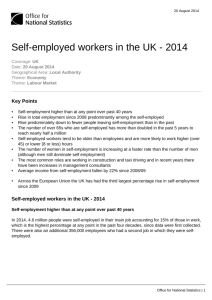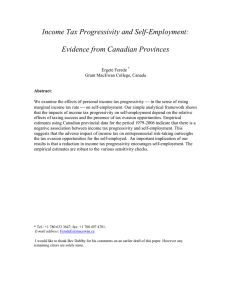Appendix 2: Analytical framework (Not intended for publication) In
advertisement
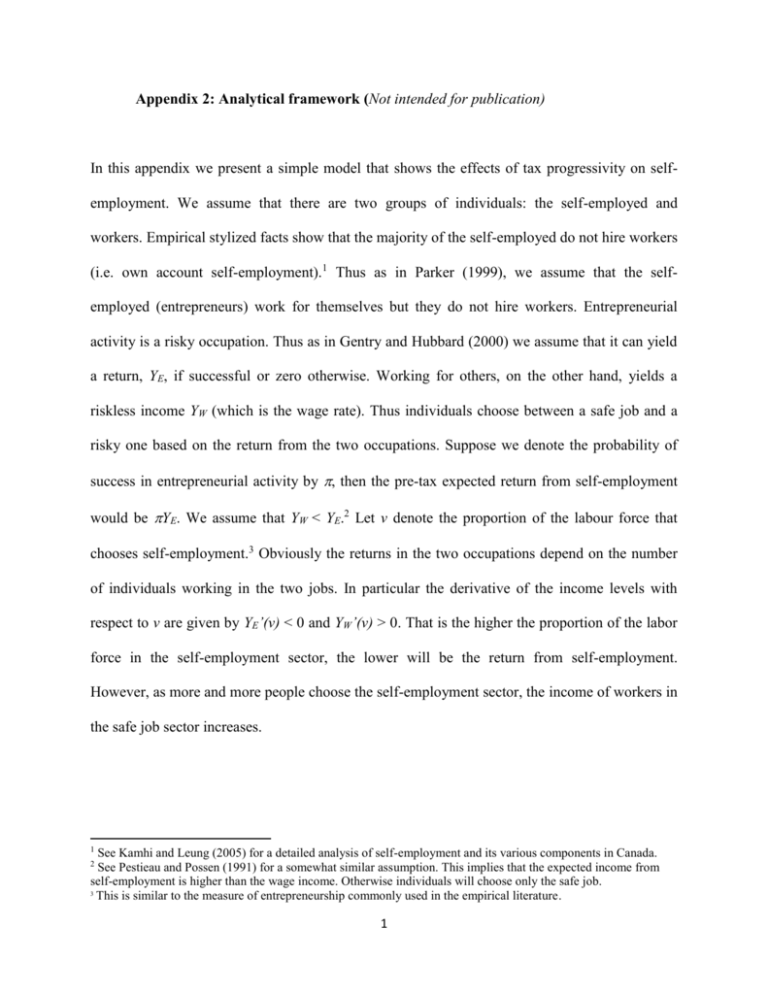
Appendix 2: Analytical framework (Not intended for publication) In this appendix we present a simple model that shows the effects of tax progressivity on selfemployment. We assume that there are two groups of individuals: the self-employed and workers. Empirical stylized facts show that the majority of the self-employed do not hire workers (i.e. own account self-employment).1 Thus as in Parker (1999), we assume that the selfemployed (entrepreneurs) work for themselves but they do not hire workers. Entrepreneurial activity is a risky occupation. Thus as in Gentry and Hubbard (2000) we assume that it can yield a return, YE, if successful or zero otherwise. Working for others, on the other hand, yields a riskless income YW (which is the wage rate). Thus individuals choose between a safe job and a risky one based on the return from the two occupations. Suppose we denote the probability of success in entrepreneurial activity by , then the pre-tax expected return from self-employment would be YE. We assume that YW < YE.2 Let v denote the proportion of the labour force that chooses self-employment.3 Obviously the returns in the two occupations depend on the number of individuals working in the two jobs. In particular the derivative of the income levels with respect to v are given by YE’(v) < 0 and YW’(v) > 0. That is the higher the proportion of the labor force in the self-employment sector, the lower will be the return from self-employment. However, as more and more people choose the self-employment sector, the income of workers in the safe job sector increases. 1 See Kamhi and Leung (2005) for a detailed analysis of self-employment and its various components in Canada. See Pestieau and Possen (1991) for a somewhat similar assumption. This implies that the expected income from self-employment is higher than the wage income. Otherwise individuals will choose only the safe job. 3 This is similar to the measure of entrepreneurship commonly used in the empirical literature. 2 1 In Canada, as in many other countries, income from self-employment is taxed as any ordinary personal income at the applicable personal income tax rates after deductions for business expenses. As extensively discussed in the literature, there is a greater tax evasion opportunity for the self-employed than for workers. Thus as in Pestieau and Possen (1991) we assume that it is difficult to evade taxes in the safe job but there is a tax evasion opportunity in the self-employed sector. Following Feldstein (1969) and Kanbur (1982), we also assume that the tax structure is progressive and for the employees it is given as TW YW 1 (1 )YW 1 , (1) where 0 < 1. TW and YW denote the tax liability and the before-tax income level of employees, respectively. > 0 is the coefficient of residual income progression (RIP) and it denotes the degree of tax progressivity.4 RIP is simply the ratio of one minus the marginal tax rate (MTR) to one minus the average tax rate (ATR).5 See Musgrave and Musgrave (1989) and Dahlby (2008) for a discussion of alternative measures of tax progressivity. The above tax structure has the following properties. If = 1, the tax structure is proportional with a marginal tax rate . While >1 shows that the tax schedule is regressive. Notice that both the marginal and average tax rate rise with income when < 1 and a lower value for implies a more progressive tax structure. As it will be clear later, the above tax formulation is useful to investigate the impact of changes in tax progressiveness (as measured by ) on self-employment. When the self-employed evade taxes, there is a probability of detection through auditing. Let the probability of detection be denoted by p. Denote also the share of income that the selfemployed conceal from taxation by where 0 1. The rate of tax evasion is assumed to be 4 The coefficient of residual income progression is also the elasticity of after-tax income to the before-tax income. 5 For our tax schedule, MTR 1 (1 )YW 1 and ATR 1 (1 )Y 1 W 2 exogenous. Thus the tax liability of successful entrepreneurs who earn the higher income YE and get away with the evasion is given by TE (1 )YE 1 (1 )(1 ) 1YE 1 . (2a) However, if caught through auditing, tax evaders pay the full tax and a certain percent of the amount of tax evaded as penalty (see Yitzhaki, 1974). Let > 0 denote the penalty rate. The tax liability of the self-employed that evade taxes and are caught through auditing is given by TE YE 1 (1 )YE 1 X , (2b) where X YE 1 (1 )YE 1 (1 )YE 1 (1 )(1 ) 1YE 1 >0. Note that TE is tax liability for those who evade taxes and X is the amount of tax liability that is evaded. In the absence of tax evasion (i.e., = 0), X will be reduced to zero. To obtain analytically tractable results, following Gentry and Hubbard (2000), we assume that individuals are risk neutral.6 For risk neutral individuals, the occupational choice simply depends on the after-tax returns from the two jobs. Equilibrium in occupational choice requires that the expected after-tax income from self-employment must be equal to the after-tax return from the safe job (employment); see Evans and Jovanovic (1989). Thus in this case, for the two occupations to exist together the following condition must be satisfied: (1 p p ) X (1 )(YE (v)) (1 )(YW (v)) , (3) where the variables are as defined before. 6 This is assumption is important to obtain analytically tractable relationship between the self-employment rate and tax progressivity. This helps us to focus on tax progressivityrather than risk aversion as the determinant of occupational choice. Previous studies such as Pestieau and Possen (1991) focused on risk aversion as the prime factor for occupational choice. 3 The left-hand side of Eq. (3) shows the after-tax expected return from self-employment. This includes the expected benefit from tax evasion which is the first term in the left-hand side. For tax evasion to be attractive this term should be positive. Otherwise, the self-employed would not evade taxes. In our analysis we assume that the expected benefit from tax evasion is positive.7 The right-hand side of the above equation on the other hand shows the after–tax return from employment. For a given , we are interested to know how changes in tax progressivity () affect the self-employment rate (v). 8 Thus totally differentiating Eq. (3) with respect to v and and noting that the income levels depend on v one would obtain: dv , d (1 p p ) XYE1YE ' (v) YE 1YE ' (v) (1 ) YW 1YW ' (v) (4) where, 1 p p X ln YW (1 ) YE ((1 )YE ) ln YE (1 )(1 ) YE ln( 1 ) >0, (1 )YE ln( YE / YW ) >0, While the denominator in Eq. (4) is negative, the sign of the numerator is ambiguous. Thus the effect of tax progressivity on self-employment is not clear from Eq. (4). In the absence of tax evasion opportunity (i.e. = 0), X and will reduce to zero.9 In this case, dv/d will be positive implying that an increase in tax progressivity (i.e., lower ) discourages selfemployment. That is the greater the tax progressivity, the lower the rate of self-employment. Thus, as Gentry and Hubbard (2000) explain, the progressive income tax has a detrimental effect on entrepreneurship and can be viewed as a “success tax”. The reason for this is straightforward. This implies that the exogenous penalty rate < (1-p)/p. If = (1-p)/p, there will be no benefit from tax evasion. For a somewhat similar exercise in a different context, see Kanbur (1982). 9 This is also true at the prohibitively high penalty rate = (1-p)/p. 7 8 4 When the tax structure becomes more progressive the government claims a higher share of the return from successful entrepreneurs (which assume the risk of earning a very low income if not successful). This discourages the risk taking behaviour of the self-employed as the government shares the reward but not the loss from the risky activity. In the presence of tax evasion opportunity, however, the relationship between tax progressivity and self-employment becomes more complicated. In fact, the sign of dv/d generally depends on the relative strength of the adverse impact of the “success tax” denoted by and the tax evasion opportunity given by .10 Eq. (4) shows that if > , dv/d will be positive and it implies that the tax evasion opportunity is lower than the detrimental effects of the “success tax”. Thus greater tax progressivity discourages self-employment. However if < , then it implies that the benefit of tax evasion opportunity outweighs the adverse impact of taxing success at a progressive rate. In this case self-employment becomes more attractive as tax progressivity increases. That is, greater tax progressivity encourages self-employment.11 In summary, the above simple model shows that in the presence of tax evasion opportunity, the impact of tax progressivity on self-employment is ambiguous. It all depends on the relative strength of the detrimental negative effects of the “success tax” and the positive effect of the tax evasion opportunity. Other things remaining constant, if the tax evasion opportunity from being a self-employed is stronger than the adverse impact of taxing success at a progressive rate, an increase in tax progressivity raises self-employment rate. On the other hand, if the tax evasion opportunity is lower (say because of a high level of tax enforcement, penalty, higher frequency of auditing, etc.) then higher tax progressivity acts as a tax on successful Notice that is equal to zero if YE =YW. If the self-employed succeed and earn the higher income (which we have assumed is greater than the income from the safe job) then becomes positive. 11 See also Parker (2003) on the impact of tax evasion opportunity on occupational choice. 10 5 entrepreneurs and discourages self-employment. Thus, the impact of tax progressivity on selfemployment is generally an empirical issue. Consequently, in our paper we explore this issue empirically using aggregate panel data from 10 Canadian provinces over the period 1979 to 2006. References Dahlby, B. (2008). The Marginal Cost of Public Funds: Theory and Applications, MIT Press, Boston. Evans, D. S. and Jovanovic, B. (1989). An estimated model of entrepreneurial choice under liquidity constraints. Journal of Political Economy 97, 808-837. Feldstein, M. (1969). The effects of taxation on risk taking. Journal of Political Economy 77, 755-764. Gentry, W. M. and Hubbard, R.G. (2000). Tax policy and entrepreneurial entry. American Economic Review 90, 283-287. Kamhi, N. and Leung, D. (2005). Recent developments in self-employment in Canada. Working Paper 2005-8, Bank of Canada, Ottawa. Kanbur, Ravi (1982). Entrepreneurial risk taking, inequality, and public policy: An application of inequality decomposition analysis to the general equilibrium effects of progressive taxation. Journal of Political Economy 90, 1-21. 6 Musgrave, Richard A. and Peggy B. Musgrave (1989). Public finance in theory and practice. London: McGraw-Hill. OECD (2001), Science, Technology and Industry Outlook, Drivers of Growth: Information Technology, Innovation and Entrepreneurship, OECD, Paris. Parker, S.C. (1999). The optimal linear taxation of employment and self-employment incomes. Journal of Public Economics 73, 107-123. Parker, S.C. (2003). Does tax evasion affect occupational choice? Oxford Bulletin of Economics and Statistics 65, 379-394. Pestieau, P. and Possen, U. M. (1991). Tax evasion and occupational choice. Journal of Public Economics 45, 107-125. Yitzhaki, S. (1974). A Note on Income Tax Evasion: A Theoretical Analysis. Journal of Public Economics 3, 201–202. 7
